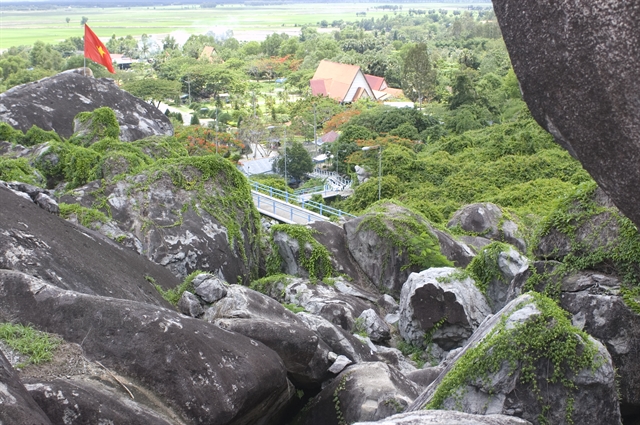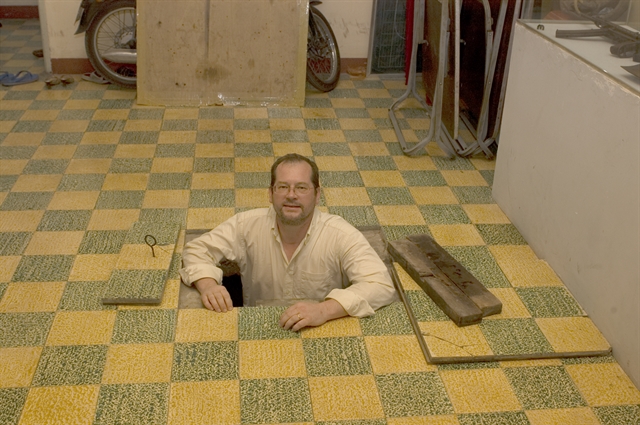 Sunday/Weekend
Sunday/Weekend

 |
| STILL STANDING: At the symbolic start of the Hồ Chí Minh Trail in March 2015. From left: Phan Mạnh Hùng (who also took us along the Trail in 2003), Clive A. Hills (photographer and co-author), Lê Đỗ Huy (researcher and co-author), Bluebelle (daughter of Virginia and Clive), Virginia Morris (researcher and author), Lưu Phương Bình (photographer), and Albion (son of Virginia and Clive). Photos by Clive Hills |
by Virginia Morris
This new tour book of war sites, written with my co-authors Lê Đỗ Huy and Clive A. Hills, has taken great determination over years of travel across Việt Nam. I first came here in 1994, drawn to this mysterious land, not only for its alluring culture and noteworthy landscapes, but because of war and how this small nation had defeated the Americans.
I relished the opportunity to visit, hoping to recapture the memories of fading battlefields, a history which would all be so new to me.
After that first visit to Việt Nam my appetite for war reminiscence had only strengthened. A small hamlet surrounded by lush fields – with bomb craters still evident between the rice plants after all this time. Fresh waterways carrying goods – previously used to ship weapons for the next fight. Intriguing alleyways leading to a market – once secret routes to outwit the enemy. These were the hidden gems I sought, but there was more – much more.
Now almost a quarter of a century on from my first visit to Việt Nam, my co-authors and I travelled throughout the country interviewing veterans and documenting both celebrated as well as little-known battlefields.
Our book, War Site Discoveries of Vietnam, is a collection of those times covering the August Revolution, the French War, the One-Way War from 1954 to 1959, the American War and the Non-American War, ending in 1975. From the One-Way War onwards, this period can also be referred to as the Vietnam War.
To understand these Vietnamese time periods we visited Hà Nội. This is the city where Hồ Chí Minh first came to power during the August Revolution in 1945. Hồ was the lead figure in the fight for independence and is seen as the liberator of Việt Nam from French colonial rule, with his approaches being used later against the Americans. We first met with General Võ Nguyên Giáp at his house where he explained some of his strategies.
 |
| GREEN VIEW: From the top of Tức Dụp Revolutionary Base, An Giang Province, the museum building can be seen in the distance. |
Later, we travelled through the bustling streets of this historic capital to search for a deeper understanding of the events which led to the birth of a nation.
To appreciate the complexities of the era between the French War and Vietnam War we journeyed to present day Đồng Nai Province. Known as the One-Way War period, it became a way for the Southern regime to eliminate the Vietnamese communists; one-way because the Soviet Union operated a policy of Peaceful Coexistence which meant the revolutionaries could not strike back.
We met with Colonel Nguyễn Trọng Tâm, a former inmate of Tân Hiệp Prison, who helped the government establish the site as a museum. While he showed us around, he explained how he had led a prison breakout from here during this One-Way War era, the results of which appeared to lead Hà Nội to the notion that armed struggle should begin.
Our next areas of interest had a connection to both the French War and Vietnam War. We travelled to base areas, including the famed D War Zone, which is now a museum, and once housed the administrative heart of the revolution and oversaw the emergence of the Liberation Army. Likewise, we trekked paths of the Southward March as well as hiked the Westward March to areas around decisive battles and former “fighting villages”.
We also spoke to those who had understood the Orient mission and how this not only facilitated the establishment of a Southern army but paved the way for the Hồ Chí Minh Trail land and sea routes. We would travel the Hồ Chí Minh Trail many times, as well as sail the waters of the Hồ Chí Minh Trail Sea Route to find sunken boats and waterlogged battlegrounds.
 |
| MANHOLE: Hills standing in the underground chamber at the museum, 'Historical Monument: Underground Arsenal', in Hồ Chí Minh City. |
We explored the iconic streets of the city formerly known as Sài Gòn and toured Huế City with spymasters of the 1968 Tết Offensive; a bloody fight which had been splashed across Western papers and now etched in the memories of people of that age.
Yet for all the symbolic glory of these great clashes, it is the voices of the remarkable female couriers and their roles as part of the Revolutionary Infrastructure, which were the most compelling. Known as the most important factor in achieving Hồ Chí Minh’s victory, these couriers penetrated every enemy base area as well as each political region; including the Presidential Palace itself. Their stories were both fascinating and courageous but frightening.
A French soldier or American combatant could never tell if their barmaid, cook or shoe-shine child was just a friendly face or a covert revolutionary courier – their friend could be their enemy.
Our excursions finished with the remote group of islands of Côn Đảo Archipelago. Today it is a region of beauty in Việt Nam, ringed with charming beaches, coral reefs and partially covered in thick forest. Yet previously it housed prisoners and on meeting survivors, their recollections of their time there highlighted to us the misery of this former place of hell.
This book will lay bare the wartime past of Việt Nam; revealed through stories told by a generation and through detailed maps and many photographs. Whether you visit the war sites or enjoy reading about these parts of the country from the comforts of your home, either way, you will most certainly have a greater understanding of the strategies used by the revolutionaries to define a nation. VNS




